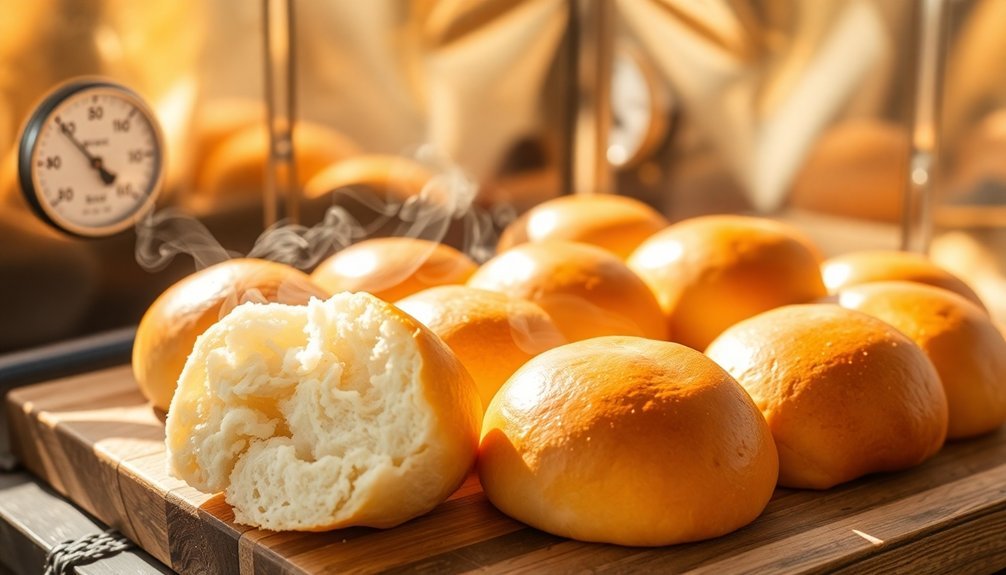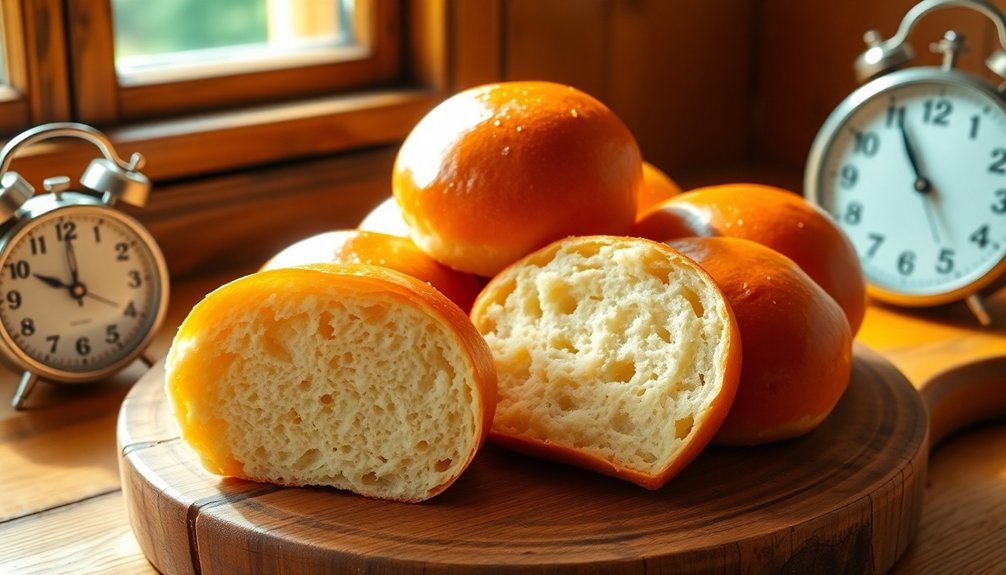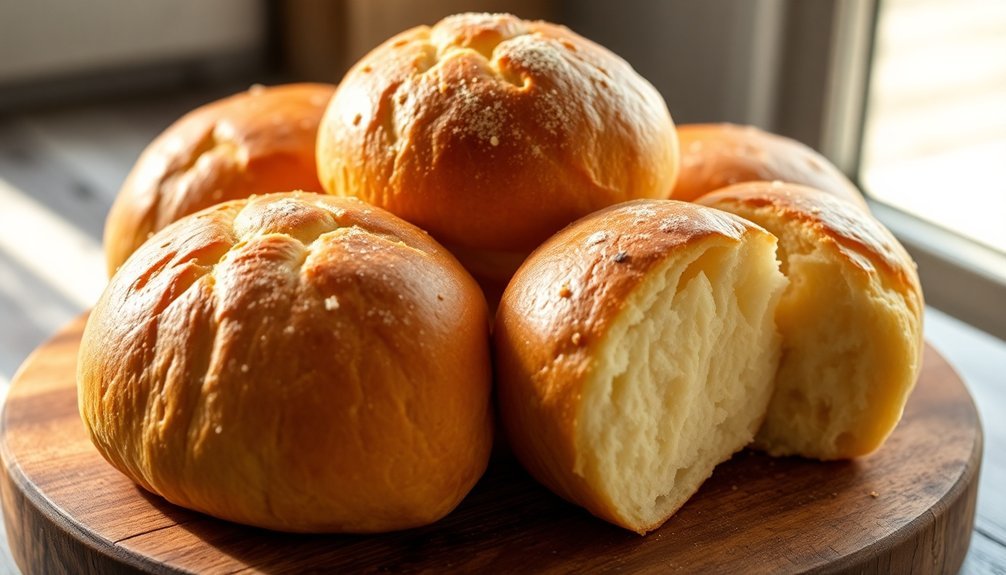Position your solar oven in full, direct sunlight with minimal wind exposure and line it with black construction paper for ideal heat retention. Don't skip the double rise method – activate your yeast in lukewarm water (105-110°F) and let the dough rise twice, keeping it in a warm environment (75-80°F) using the solar oven's heat. Time your bake between 10 AM and 4 PM when the sun's strongest, and rotate the oven as needed to maintain consistent temperature. While solar baking requires patience, these fundamentals will help you master the art of creating perfectly fluffy rolls that'll impress your family and friends.
Perfect Your Solar Oven Setup

A successful solar-baked roll starts with positioning your solar oven correctly. Find a spot with full, direct sunlight and minimal wind exposure, ensuring there's nothing blocking the sun's rays.
You'll want to set up on a level surface to achieve even baking temperatures throughout your rolls. Position your oven so it's facing directly toward the sun, and prop the reflective flaps at ideal angles using a straight edge. Consider using a ruler for adjustment to precisely control flap angles.
You'll need to rotate and adjust the oven frequently as the sun moves across the sky – when positioned correctly, the shadow should fall directly behind your oven.
Create an effective heating environment by lining the bottom with black construction paper and adding insulation like crumpled newspaper around the cooking area.
Seal the opening with clear, tight plastic wrap to create a greenhouse effect, and check that there aren't any gaps where heat could escape. Don't forget to add reflective surfaces like aluminum foil to maximize sun exposure.
Keep your setup clean and efficient by regularly wiping down glass and reflective surfaces with a vinegar-water solution.
Monitor weather conditions and adjust your setup accordingly to maintain consistent heating.
Master The Double Rise Method
With your solar oven perfectly positioned, let's focus on the double rise technique that creates those irresistibly fluffy rolls.
Start by activating your yeast in lukewarm water (105-110°F), then combine it with unbleached all-purpose or bread flour for ideal gluten development.
For your first rise, you'll need to maintain a warm environment between 75-80°F, which your solar oven's residual heat can help achieve. Be sure to add salt after activation to support proper gluten development while protecting the yeast.
Place your dough in a lightly oiled bowl, cover it with a damp towel, and let it double in size over about 60 minutes.
When it's time to shape your rolls, divide the dough into equal portions and form smooth balls using the circle method with your thumb and fingers.
Butter your pan using a saved wrapper, and fill it to two-thirds capacity. Let the shaped rolls rise again for 15-20 minutes, until they've increased by about 50%.
Don't let your rolls over-rise during this second phase – they should just crest the pan's top.
When they're ready, bake them in your solar oven at 350-375°F for 14-17 minutes until golden brown.
Time Your Bake Right

Successful solar baking depends heavily on understanding your oven's temperature patterns throughout the day.
You'll get the best results between 10:00 AM and 4:00 PM in summer, or 11:30 AM to 2:30 PM in winter, when your solar oven can reach ideal temperatures of 300-350°F.
Before placing your rolls in the oven, allow 20-30 minutes for preheating.
You'll need about 30-40 minutes of baking time when your oven maintains 340°F or higher. If you're baking on a cooler day when temperatures hover between 250-300°F, plan for longer baking times and adjust your schedule accordingly. Traditional electric ovens only need 16 minutes at 375°F.
Keep your eye on both the temperature and the sun's position.
You'll need to rotate your oven periodically to maintain consistent heat. Use smaller baking containers and avoid overcrowding your rolls to guarantee even baking.
During the bake, check your rolls regularly, especially if the temperature fluctuates.
Don't rush to remove them – solar ovens are forgiving, and it's better to confirm they're fully baked than to end up with underdone centers.
Frequently Asked Questions
Can I Store Leftover Dough in the Refrigerator for Later Use?
Yes, you can store your yeast dough in the fridge for up to 24 hours. Just keep it in a loosely covered container, rub some olive oil on top, and let it warm up before using.
What Alternatives Can I Use if I Don't Have Bread Flour?
You can use all-purpose flour as your main substitute for bread flour. If you want a chewier texture, add essential wheat gluten (5g per 115g of all-purpose flour) to mimic bread flour's properties.
How Do I Adjust Ingredients When Baking in High-Altitude Locations?
At high altitudes, you'll need to reduce leavening agents and sugar while increasing liquids. Decrease baking powder by 1/8-1/4 teaspoon per teaspoon, add 2-4 tablespoons more liquid per cup, and slightly reduce sugar.
Why Do My Rolls Develop a Hard Bottom Crust?
Your rolls' hard bottom crust likely comes from direct heat exposure. You'll want to try using an insulated pan, lowering the oven temperature, or placing parchment paper underneath to create a barrier.
Can I Freeze Baked Rolls and Reheat Them Later?
Yes, you can freeze baked rolls for up to a month. Just cool them completely, store them in an airtight container, and reheat in a 350°F oven for 8-15 minutes when you're ready to serve.
In Summary
You'll get consistently fluffy solar-baked rolls by focusing on these three key steps. Set up your solar oven properly with ideal angle and insulation, let your dough rise twice for extra lightness, and time your bake during peak sun hours. With practice, you'll master these techniques and enjoy perfect, pillowy rolls that harness the sun's energy – making you a true solar-baking expert.





Leave a Reply